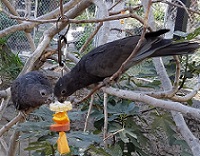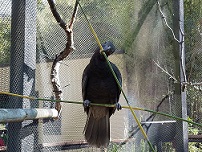Black Parrot
Coracopsis nigra
- Habitat: tropical rainforests and mangroves
- Range: found in Comoros, Seychelles and Madagascar
- Natural Diet: fruits and buds
- Status in the Wild: Common
All about the Black Parrots
Black parrots belong to the parrot family, the Psittacine. They are monomorphous with males and females being of the same color, size, shape, and form. They have pinkish-white bills that turn grey after a molt, greyish-black primary feathers, and brownish-black tail feathers. The color of their plumage helps camouflage them from predators. They are about a foot in body length and weigh about half a pound.
Diet/ Habitat/ Range
Black Parrots are endemic to Madagascar. They mainly feed on seeds, fruits, leaves, buds, nectar, pollen, and flowers.
Behavior
Black parrots do not maintain territories nor protect them. Instead, they maintain nesting cavities, often tree hollows. They emit a range of vocalizations from soft whistles to loud shrieks. Soft whistles are contact calls used when they communicate with their partners. The loud shrill shrieks are alarm calls made to alert the colony to the presence of a predator.
Reproduction
Black parrots are monogamous with the females selecting single male partners that they pair and breed with for life. The breeding season is usually in the spring. Females initiate the reproductive behavioral sequence by vocalizing to the male she has selected, to attract his attention and begging to be fed. Breeding takes place when he commences feeding her, after which, she builds her nest and lays her eggs. This behavior is the female making certain that the male will feed her while she is incubating her eggs and is unable to leave the nest.
Conservation/Status
Since the Black Parrot populations in the wild have been estimated to be currently stable, they are categorized as Least Concern by the International Union for World Conservation.

.jpg)
